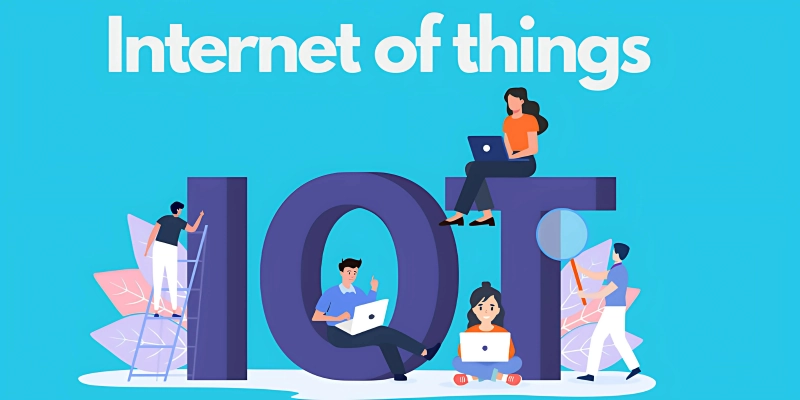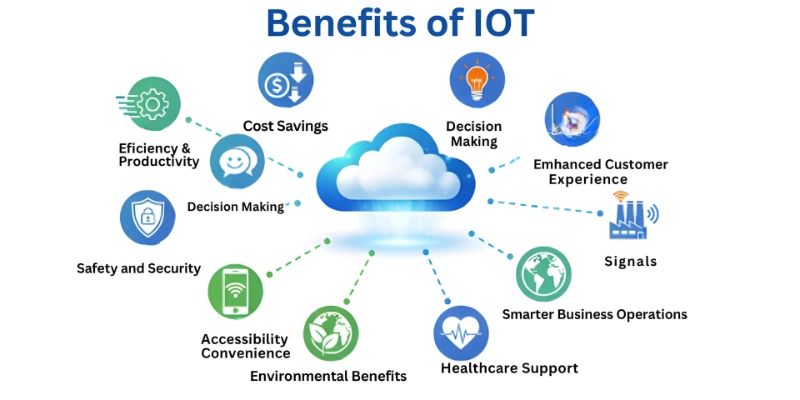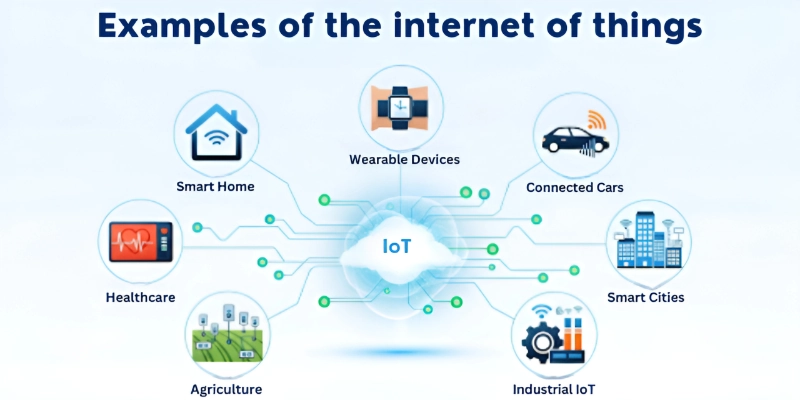Internet of Things (IoT): 10 Key Benefits and Challenges and examples
Published: 31 Aug 2025
The way the Internet of Things (IoT) is changing how we live and work is its greatest advantage, and they are transforming the benefits of Internet of Things (IoT) by transforming how we live and work. But have you ever thought about what is really for you beyond all publicity? The benefits of Internet of Things far surpass those of smart devices, as they solve real-world problems such as reducing energy bills, saving time on manual tasks, and enhancing home safety. Imagine waking up for fresh coffee automatically, while your car maps the best traffic-free route to work.

Until cost savings and security provide IoT practical value that is originally mixed in everyday life.
What is the Internet of Things (IoT)?
The Internet of Things (IoT) means that everyday equipment connected to the Internet means that they can collect, share, and act on data. This is not just about a computer or smartphone; think of training trackers that record your steps, cars that lead you with GPS, or a smart home, checking the lights with your phone. IoT means something today because it saves time, improves comfort, and helps people and businesses make better choices.
10 Key Benefits of Internet of Things (IoT)
The Internet of Things (IoT) offers many advantages that make life easier, businesses smarter, and the world more connected. Here is the list of 10 Benefits of Internet of Things (IoT).
- Improved Efficiency & Productivity
- Cost Savings
- Better Decision Making
- Enhanced Customer Experience
- Safety and Security
- Accessibility and Convenience
- Environmental Benefits
- Smarter Business Operations
- Healthcare Support
- Smarter Cities
Let’s explain these Benefits of the Internet of Things (IoT) one by one.
🌐 Key Benefits of Internet of Things (IoT)
IoT offers many advantages that make life easier, businesses smarter, and the world more connected. Let’s get the Benefits of Internet of Things

1.⚡ Improved Efficiency & Productivity
IoT makes tasks faster and smoother by automating processes.
- Automates repetitive tasks at home and work.
- Reduces manual errors with smart tracking systems.
- Increases the overall speed of business operations.
- Machines monitor their own performance and report issues.
- Frees up employees for more important jobs.
- Ensures better coordination between devices.
- Saves time in both personal and professional life.
- Boosts productivity in industries and daily routines.
2.💰 Cost Savings
IoT helps save money by cutting waste and preventing expensive problems.
- Smart lighting and thermostats lower energy bills.
- Sensors detect small faults before big breakdowns.
- Predictive maintenance reduces repair costs.
- Saves money by avoiding production downtime.
- Reduces labor costs with automation.
- Helps families manage electricity bills at home.
- Optimizes resources in businesses for maximum savings.
- Increases long-term return on investment.
3.📊 Better Decision Making
IoT provides real-time data that helps in making smarter choices.
- Collects accurate data instantly from devices.
- Helps businesses understand customer behavior.
- Farmers use IoT to monitor soil and crops.
- Removes guesswork with factual insights.
- Enables quick and informed decision-making.
- Helps companies predict market demand.
- Supports planning with real-time updates.
- Improves results in both business and daily life.
4.😊 Enhanced Customer Experience
IoT makes services more personal, faster, and convenient for users.
- Offers personalized services based on habits.
- Smart apps adjust to customer preferences automatically.
- Provides faster and smoother customer support.
- Fitness devices give customized health advice.
- Makes everyday tasks more enjoyable and easier.
- Increases customer trust in brands.
- Creates comfort with technology-driven solutions.
- Builds loyalty with improved experiences.
5.🔒 Safety and Security
IoT increases safety by monitoring environments and alerting users in real time.

- Smart locks and cameras protect homes.
- Sensors detect fire, smoke, and gas leaks.
- Wearables send emergency alerts in healthcare.
- Real-time monitoring prevents big risks.
- Protects sensitive business data from breaches.
- Tracks vehicles to improve transport safety.
- Improves workplace safety with connected devices.
- Provides peace of mind for families and companies.
6.🏠 Accessibility and Convenience
IoT gives people more control and comfort in daily life.
- Devices can be controlled remotely using smartphones.
- Switch off lights or appliances from anywhere.
- Voice assistants like Alexa add convenience.
- Saves time in daily household activities.
- Offers comfort for elderly and disabled people.
- Provides quick solutions without physical effort.
- Makes smart homes easier to manage.
- Brings flexibility to modern lifestyles.
7.🌱 Environmental Benefits
IoT supports eco-friendly living by reducing waste and saving resources.
- Smart irrigation systems save water in agriculture.
- Smart streetlights reduce electricity usage.
- Monitors energy use to avoid wastage.
- Lowers carbon emissions with efficient systems.
- Supports global sustainability goals.
- Encourages businesses to go green.
- Reduces pollution with smart transportation.
- Promotes eco-friendly lifestyles at home.
8.🏢 Smarter Business Operations
IoT helps businesses run smoothly with automation and better tracking.
- Tracks goods in supply chains to avoid delays.
- Keeps inventory updated automatically.
- Reduces losses during transport.
- Improves delivery speed and accuracy.
- Provides real-time updates on stock and sales.
- Optimizes warehouse management.
- Ensures smooth customer service processes.
- Increases profits with efficient operations.
9.🏥 Healthcare Support
IoT makes healthcare smarter, safer, and more affordable.
- Wearables track heart rate, sleep, and activity.
- Devices share health data with doctors instantly.
- Real-time alerts save lives in emergencies.
- Helps patients with long-term conditions.
- Reduces the need for frequent hospital visits.
- Improves treatment with accurate monitoring.
- Supports remote patient care from home.
- Lowers healthcare costs for families and hospitals.
10.🏙️ Smarter Cities
IoT transforms cities into safer, cleaner, and more efficient places to live.
- Smart traffic lights reduce road Overcrowding.
- Sensors manage waste collection in bins.
- Streetlights save energy by working only when needed.
- Improves air quality monitoring.
- Enhances public transport efficiency.
- Keeps cities safer with connected surveillance.
- Promotes sustainability in urban areas.
- Builds modern, future-ready cities.
All these benefits of the Internet of Things (IoT) help you stay connected, improve efficiency, and make smarter decisions in everyday life and business.
Real-Life Examples of IoT 🌟
Here are some real-life examples of the Benefits of the Internet of Things

- Smart Homes: Nest thermostat, Ring doorbell.
- Healthcare: Smartwatches, connected medical monitors.
- Transportation: GPS trackers, connected cars.
- Agriculture: Smart irrigation systems.
- Retail: Utilizing smart shelves and RFID tags for efficient inventory management.
Challenges of IoT ⚠️
While the benefits are huge, there are also challenges of IOT:
- Risks to security and privacy: susceptible to data breaches and hacking.
- Data management and storage: handling large amounts of data effectively is necessary.
- Devices from various vendors frequently have interoperability problems.
- Dependency on networks and connectivity necessitates a robust, dependable internet.
- High Implementation Costs: Upkeep and infrastructure can be costly.
- Scalability issues: managing a lot of devices can be challenging.
- Regulatory and Compliance Issues: Diverse international regulations and norms.
- Many IoT devices have limited power due to their high energy consumption and short battery life.
📝 Conclusion
The Internet of Things (IoT) is no longer just an emerging concept; it is already making life easier, safer, and smarter. From energy savings and cost cuts to health services, businesses, and even throughout the cities, the benefits of the Internet of Things shape a connected future. It gives more comfort at home, increases productivity in industries, and supports an environmentally friendly life.
Although the benefits of Internet of Things are powerful, it is important to be vigilant for security risks, privacy considerations, and more dependence on connected equipment. Always choose a reliable solution and practice safe use to avoid general errors.
FAQs
It simply means how IoT makes life easier, like saving energy, reducing costs, and improving comfort.
No. Most IoT devices are user-friendly and controlled through mobile apps.
Check your Wi-Fi range, restart the device, and make sure the password is correct.
Yes, but always set strong passwords, update apps, and buy from trusted brands.
Yes. Smart thermostats, lighting, and appliances lower bills by reducing unnecessary energy use.
They track performance data like reduced downtime, lower costs, and improved customer satisfaction.
Check network strength, update firmware, and confirm compatibility between devices.
Not 100%. Sensors may give errors, but regular calibration and maintenance improve accuracy.
Businesses can secure IoT systems by using strong authentication, updating firmware regularly, and encrypting all data. They should also segment IoT devices on separate networks and monitor traffic for unusual activity. Choosing trusted vendors and having an incident response plan further reduces security risks.
The most common mistake businesses make with IoT is failing to secure devices by leaving default passwords and weak configurations unchanged. This creates easy entry points for hackers and puts sensitive data at risk. Many companies also rush deployment without proper planning for updates, monitoring, and long-term security.
The are 5 benefits of the Internet of Things:
- Improved efficiency and productivity
- Cost savings
- Better decision-making
- Enhanced customer experience
- Safety and security

- Be Respectful
- Stay Relevant
- Stay Positive
- True Feedback
- Encourage Discussion
- Avoid Spamming
- No Fake News
- Don't Copy-Paste
- No Personal Attacks

- Be Respectful
- Stay Relevant
- Stay Positive
- True Feedback
- Encourage Discussion
- Avoid Spamming
- No Fake News
- Don't Copy-Paste
- No Personal Attacks





